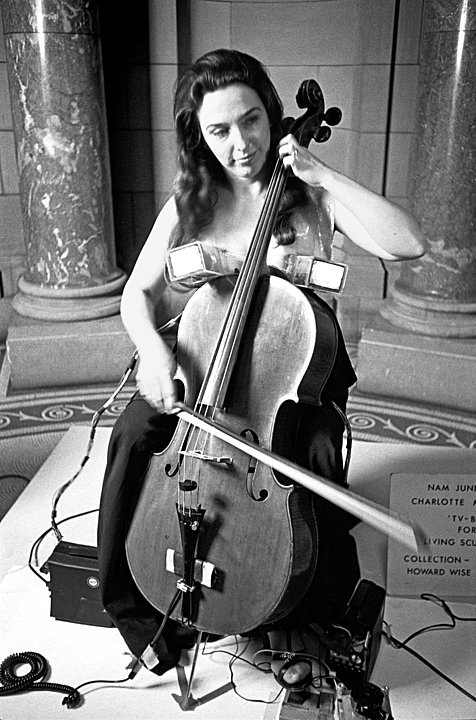
In a world of online zines, /r/art, and Instagram, art is more shareable, more versatile, and more accessible than ever before. From Jenny Holzer truisms printed on graphic tees to i-D magazine, artists of today are able to defy convention, provoke discussion, or simply titillate on an unprecedented scale. This kind of creative access has transformed art – no matter how low-budget, eccentric or polarizing – from an elite discipline of high culture to a platform for experimentation, resistance, provocation and spectacle.
This radical shift in the art climate has its roots in the early avant-garde art of the 60s and 70s, when artists began to use reality as source material, in the process radically stretching the boundaries of art’s form and function. Central to this movement was Charlotte Moorman, a cellist, performance artist, and “Jeanne d’Arc of new music” whose life, art, and legacy is the focus of the Block Museum’s recently debuted exhibition, A Feast of Astonishments: Charlotte Moorman and the Avant-Garde, 1960s-1980s.
The Charles Deering McCormick Library of Special Collections obtained the Charlotte Moorman Archives in 2001, joining Dick Higgins’ and John Cage’s works in Northwestern’s growing avant-garde collection. Tapping into the resources here at Northwestern, the Block Museum is the first museum to showcase this comprehensive collection of Moorman’s life and work. After its run at the Block, the exhibit will travel to the NYU’s Grey Art Gallery and the Museum der Moderne Salzburg in Austria.
The showcase fills the Block Museum’s three gallery spaces and features documents, artifacts, correspondences, performance footage and video art from Moorman’s oeuvre and the works she inspired. The smaller Katz Gallery houses Don’t Throw Anything Out: Charlotte Moorman’s Archive, an adjoined showcase of everything from grocery lists to diary entries that, when presented together, reflect the spectrum and spectacle of Moorman’s life. Moorman’s final words, which title this exhibit, demonstrate the inimitable nature of the “life as art” philosophy that guided her.
“Since most of her work was performance or time based, we used these artifacts and documentation to tell and enliven her story,” said Corinne Granof, Curator of Academic Programs for the Block Museum, “What the Moorman exhibition does is showcase a moment in history; or rather, a person as a part of history.”
The larger Main Gallery, quite appropriately, contrasts the serene paper trail of Don’t Throw Anything Out. The videos, photos, music scores, artifacts and transcripts document Moorman’s creative work and frequent collaborations with the likes of Nam June Paik and Yoko Ono. Relics of her performances, which ranged from highly conceptual public appearances (“TV Bra for Living Sculpture” in which she plays the cello topless, wearing only a bra made of small TVs) to subtly political pieces (“Bomb Cellos” and “Per Arco”, where Moorman appropriates the sights and sounds of war), are woven into the oft-overlooked early history of contemporary art, such as the annual New York Avant Garde Festivals, which Moorman organized between 1963 and 1980.
The exhibit not only showcases Moorman’s commitment to subversive, alternative art but also documents the kind of personal archive that predates the Instagram era. It’s an archive that depends equally on vestiges of life’s minutiae as well as the grandeur of performance to highlight her role as a seminal figure in contemporary art history. As an art exhibit, A Feast of Astonishments is indisputably unconventional. It relies not just on static pictures or audio clips but also on testimony, memorabilia, and the kind of compulsive documentation Baby Boomers berate Millennials for. But to chronicle the art – and thus, the life – of Charlotte Moorman, nothing but the unconventional would do her justice.
“She’s been under the radar even though she played such an important role in the 60s-80s. She was an important voice and connector working with artists abroad. With this exhibit, we wanted rewrite the history and include her,” said Granof, “It is an opportunity to understand her work and her influence - why and how she was instrumental in bringing the experimental and avant-garde to a broader audience, how she questioned conventions of art and music, and reexamined how we define art itself.”
A Feast of Astonishments: Charlotte Moorman and the Avant-Garde, 1960s-1980s is on display until July 17th. Check out the Block Cinema’s associated film screenings (http://www.blockmuseum.northwestern.edu/view/cinema/CharlotteMoorman.html) and related gallery talks and events throughout the month of January.